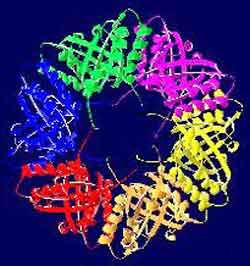New Protein Discovered By Hebrew University Researchers Holds Promise For Use In Medicine And Nanoscience

"Bagel-shaped" SP-1 protein
Researchers at the Hebrew University of Jerusalem have succeeded in discovering and isolating a new protein from the poplar tree with special structural and qualitative characteristics that could have consequences for development of future nanocapsules for drug delivery to cancer cells.
In addition to being obtained from plant tissue, the protein can now also be produced in large quantities as a recombinant protein in bacteria, making it highly available for medicinal or other applications.
Called SP-1, the protein has a nanometric, “bagel-shaped,” circular form and is extremely stable. It has been found to be capable of surviving contact with enzymes that break down proteins or exposure to extreme conditions such as boiling, excessive acidity, salinity, organic solvents or detergent solutions.
The research was conducted at the Hebrew University’s Faculty of Agricultural, Food and Environmental Quality Sciences in Rehovot by Prof. Arie Altman, head of the faculty’s Robert H. Smith Institute of Plant Sciences and Genetics in Agriculture, and Prof. Oded Shoseyov, with the participation of Dr. Wangxia Wang and Dr. Dan Pelah and the scientists of Fulcrum SP Ltd.: Dr. Amnon Wolf, Dr. Ira Marton and Dr. Yehonathan Pouny.
According to Profs. Altman and Shoseyov, the SP-1 protein serves to assist in creating a properly folded and functioning structure of other proteins within the plant’s cells. The SP-1 also has the ability to assemble itself into a structure composed of 12 identical units, making it exceptionally resistant to extreme conditions. These qualities are rarely found among proteins and make the SP-1 a promising candidate for a multiplicity of uses in developing medicinal applications in the rapidly growing field of nanobiotechnology.
SP-1 nanocapsules will be capable of delivering cell-destroying drugs specifically to certain types of solid cancer tumors. The protein’s tiny structure enables this carrier to penetrate specifically into tumors without harming healthy tissue and thus enhance the effectiveness of chemotherapy. This selective penetration is based on the fact that the blood vessels which feed tumors are considerably more porous than those reaching healthy cells. Therefore, the units of SP-1 carrying the drug would invade only the tumor-feeding blood vessels and not normal ones.
More recently, the three-dimensional structure of the protein was deciphered by x-ray crystallography in the laboratory of Dr. Orna Almog of Ben-Gurion University of the Negev. The research on this was published in the Journal of Biological Chemistry issue of December 2004, authored by Or Dgany of the Hebrew University, Ana Gonzales of Stanford University, Oshrat Sofer of Ben-Gurion University, Wangxia Wang of the Hebrew University, Gennady Zolotnitsky of the Technion, Amnon Wolf of Fulcrum, Yuval Shoham of the Technion, Arie Altman of the Hebrew University, Sharon G. Wolf of the Weizmann Institute, Oded Shoseyov of the Hebrew University and Orna Almog of Ben-Gurion University.
Professors Altman and Shoseyov are the scientific founders of the biotech start-up company Fulcrum SP Ltd. that is developing the SP-1 protein for cancer drug delivery and other applications.
For further information: Jerry Barach, Dept. of Media Relations, the Hebrew University, tel: 02-588-2904, or Orit Sulitzeanu, Hebrew University spokesperson, tel. 052-2608016.
Media Contact
More Information:
http://www.huji.ac.ilAll latest news from the category: Life Sciences and Chemistry
Articles and reports from the Life Sciences and chemistry area deal with applied and basic research into modern biology, chemistry and human medicine.
Valuable information can be found on a range of life sciences fields including bacteriology, biochemistry, bionics, bioinformatics, biophysics, biotechnology, genetics, geobotany, human biology, marine biology, microbiology, molecular biology, cellular biology, zoology, bioinorganic chemistry, microchemistry and environmental chemistry.
Newest articles

High-energy-density aqueous battery based on halogen multi-electron transfer
Traditional non-aqueous lithium-ion batteries have a high energy density, but their safety is compromised due to the flammable organic electrolytes they utilize. Aqueous batteries use water as the solvent for…

First-ever combined heart pump and pig kidney transplant
…gives new hope to patient with terminal illness. Surgeons at NYU Langone Health performed the first-ever combined mechanical heart pump and gene-edited pig kidney transplant surgery in a 54-year-old woman…

Biophysics: Testing how well biomarkers work
LMU researchers have developed a method to determine how reliably target proteins can be labeled using super-resolution fluorescence microscopy. Modern microscopy techniques make it possible to examine the inner workings…





















